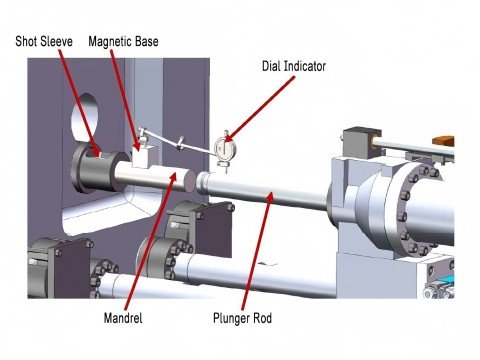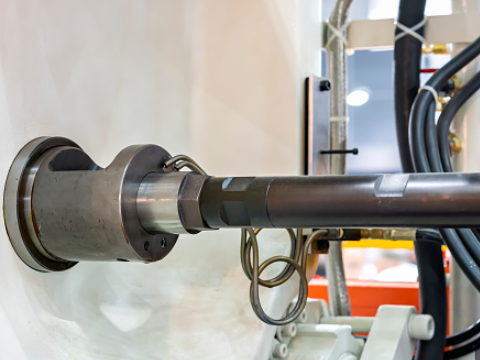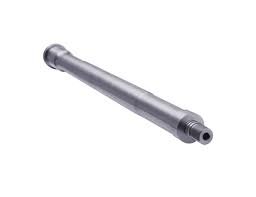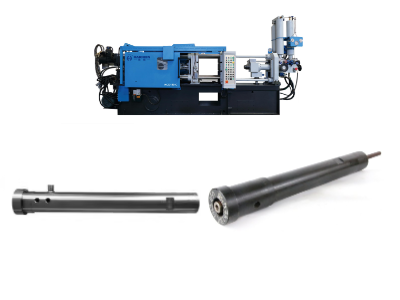In die casting, a plunger rod is an essential component of the injection system. Its primary function is to push molten metal into the die cavity under high pressure.

The function of plunger rod in die casting

The plunger rod in die casting is an important part of the injection unit of a die casting machine. And its main function is to transport the molten metal from the shot cylinder to the mold cavity.
Plunger rods are usually made of steel, such as H13 or 45# steel, and are heat-treated and surface-treated to increase durability.
Forcing Molten Metal into the Die Cavity
- Mechanism: In die casting, the plunger rod is positioned above the gooseneck or shot chamber, which contains the molten metal. When the plunger rod moves downward, it displaces the molten metal and forces it through the nozzle and into the die cavity at high speed.
- Importance: This rapid injection of molten metal ensures that the metal fills the die cavity quickly and completely. It minimizes the risk of defects such as porosity or incomplete filling.
Controlling Metal Flow
- Speed and Pressure: The plunger rod can be designed to control the speed and pressure of the metal flow. By adjusting the speed of the plunger rod’s movement. The rate at which the molten metal is injected into the die can be controlled. This is critical for ensuring proper filling of the die cavity and for preventing defects such as cold shuts or turbulence.
- Consistency: The plunger rod helps maintain a consistent flow of molten metal, which is essential for producing high-quality castings with uniform dimensions and properties.
Ensuring Proper Die Filling
- Complete Filling: The plunger rod ensures that the entire die cavity is filled with molten metal. This is particularly important for complex parts with thin walls or intricate geometries, where incomplete filling can lead to scrap parts.
- Minimizing Defects: By ensuring that the die cavity is filled quickly and completely, the plunger rod helps minimize defects such as shrinkage, porosity, and gas entrapment. These defects can weaken the final product and affect its performance.
Mechanical and Thermal Resistance
- Durability: High temperatures and pressures act on the plunger rod during the die casting process. The plunger rod material must withstand these conditions without deforming or wearing out quickly.
- Material Selection: High-strength steel or specialized alloys resistant to thermal and mechanical stresses are common choices for the plunger rod. This ensures that it can operate reliably over a long period of time.
Sealing and Isolation
- Preventing Backflow: The plunger rod helps prevent molten metal from flowing back into the shot chamber once it has been injected into the die cavity. This is important for maintaining the proper volume of metal in the die and for ensuring consistent part quality.
- Isolation: In some designs, the plunger rod also helps isolate the molten metal in the shot chamber from the rest of the machine, preventing contamination and ensuring a clean injection process.
Maintenance and Quality Control

- Regular Inspection: The condition of the plunger rod is critical for the quality of the castings. Regular inspection and maintenance are necessary to detect wear, damage, or defects that could affect the injection process.
- Replacement: If the plunger rod becomes worn or damaged, it must be replaced to ensure consistent and high-quality castings. This is an important aspect of maintaining the overall efficiency and reliability of the die casting process.
Construction and Materials of plunger rod
Manufacturers typically use high-temperature and high-pressure resistant materials for plunger rods, such as heat-resistant, corrosion-resistant high-strength steel or specialized alloys.
Plunger rods directly contact molten metal, which reaches temperatures from several hundred to over a thousand degrees Celsius, depending on the metal type. For instance, zinc die casting uses lower molten metal temperatures than aluminum or magnesium die casting. The plunger rod also needs to be strong enough to withstand the mechanical forces generated during the injection process.
Die Casting plunger rod supplier: Haichen Machinery
Haichen Machinery is a Chinese company specializing in the manufacturing and supply of aluminum cold chamber die casting machines, hot chamber die casting machines and related equipment.
Key Features of Haichen Machinery’s Plunger Rods:

Material: Typically made from H13 tool steel or other high-grade alloys with heat treatment for extended lifespan.
Precision Machining: Ensures tight tolerances for smooth operation in the shot sleeve.
Surface Treatments: May include nitriding, chrome plating, or tungsten carbide coatings for wear resistance.
Customization: Available in various diameters and lengths to fit different die casting machines.
Cooling Options: Some models feature internal water cooling to reduce thermal stress.
Plunger rod is an indispensable key component in the die casting process. And its design, material selection and maintenance directly affect the quality and production efficiency of die castings. Therefore, in the selection and use of plunger rod, need to comprehensively consider its mechanical properties, thermal properties and compatibility with the mold system.



